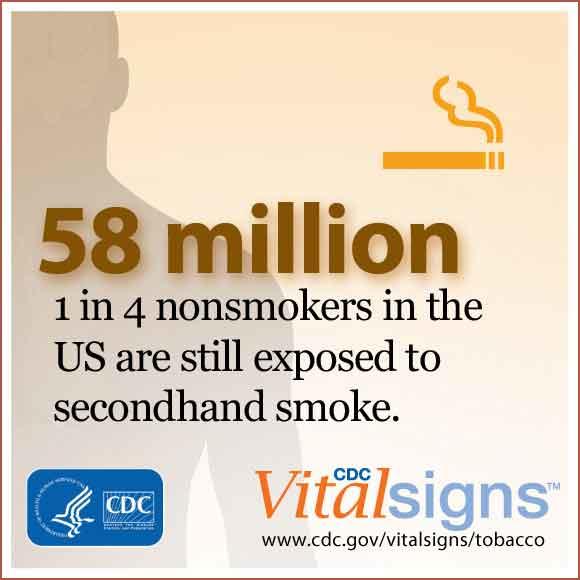Exposure to Secondhand Smoke Plummets, but Disparities Persist
, by NCI Staff
Secondhand smoke exposure in the United States fell by 50 percent from 1999 to 2012, according to a new study by investigators at the Centers for Disease Control and Prevention (CDC). However, they estimated that 58 million people in the United States were still exposed to secondhand smoke through cigarette smoking in 2011–2012.
Secondhand smoke causes disease and death in nonsmoking children and adults, and there is no risk-free level of secondhand smoke exposure. In the study, published in Morbidity and Mortality Weekly Report (MMWR), David Homa, Ph.D., and his colleagues examined National Health and Nutrition Examination Survey data from 1999 to 2012 to examine secondhand smoke exposure among the nonsmoking population. Secondhand exposure was assessed among nonsmokers over 3 years of age by measuring levels of serum cotinine levels (a metabolite of nicotine).
The investigators found that the prevalence of secondhand exposure in nonsmokers declined from 52.5 percent in 1999–2000 to 25.3 percent in 2011–2012. Although declines were observed for all population subgroups, there were several notable disparities in exposure, they reported. In 2011–2012, secondhand smoke exposure was highest among children aged 3 to 11 years (40.6 percent), non-Hispanic blacks (46.8 percent), persons living below the poverty level (43.2 percent), and persons living in rental housing (36.8 percent). Among children aged 3 to 11 years, 67.9 percent of non-Hispanic blacks were exposed to secondhand smoke, compared with 37.2 percent of non-Hispanic whites and 29.9 percent of Mexican Americans.
“These findings underscore the importance of continued efforts to reduce secondhand smoke exposure in all settings to protect nonsmokers, particularly children,” Dr. Homa and his colleagues wrote.
Promotion of other smoke-free policies, including comprehensive statewide laws that prohibit smoking in workplaces and public places and smoke-free policies in multiunit housing, “are critical to protect nonsmokers from this preventable health hazard in the places they live, work, and gather,” they concluded.
The full study is available on the MMWR website. Resources on quitting smoking are available on smokefree.gov, and you can learn more about secondhand smoke and cancer in this NCI fact sheet.
